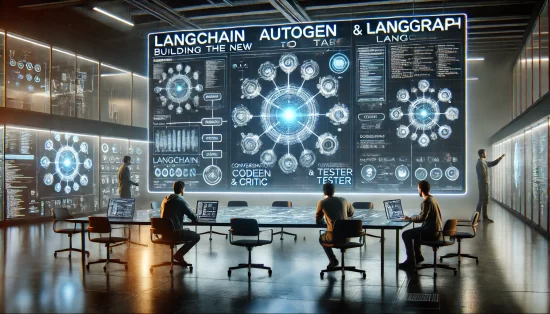Artificial Intelligence is evolving fast—and so is the developer toolbox that powers it.
Gone are the days when interacting with an LLM meant typing a prompt into a box and hoping for the best. Today, we’re building intelligent, autonomous systems that can reason, plan, retrieve data, and even collaborate with each other.
This transformation has been made possible by powerful open-source frameworks like LangChain, AutoGen, and LangGraph.
Each tool brings a unique superpower to the AI workflow:
-
LangChain: modular LLM pipelines
-
AutoGen: multi-agent collaboration
-
LangGraph: structured, state-aware planning
If you’re a developer, researcher, or AI product builder, understanding these tools is no longer optional—it’s essential.
Let’s explore what each of these tools does, why they matter, and how they can work together to build the future of AI.

LangChain: Connecting the LLM Dots
What it is:
LangChain is a framework that simplifies building LLM-powered applications by chaining together language models, data sources, retrieval systems, and custom logic into a coherent pipeline.
Think of it as the middleware for AI workflows.
What it enables:
-
Step-by-step workflows with memory
-
Integrating tools like search, APIs, databases
-
Context-aware question answering
-
Document analysis and summarization
Why it matters:
LangChain abstracts the complexity of prompting, parsing, and handling LLM outputs. You can chain models with external tools and services, enabling robust AI experiences—like a chatbot that can pull real-time data or summarize hundreds of PDFs.
Use Case Example:
A legal assistant that:
-
Retrieves documents using vector search.
-
Summarizes them using an LLM.
-
Outputs a legally formatted report.
All powered through LangChain chains.
AutoGen: Multi-Agent Conversations Made Easy
What it is:
AutoGen is a framework from Microsoft that makes it easy to build conversational multi-agent systems—LLMs that talk to each other to solve problems.
It’s like giving your AI agents personalities, roles, and responsibilities—and letting them figure things out together.
What it enables:
-
Autonomous agents with distinct roles
-
Human-in-the-loop interactions
-
Task delegation among agents
-
Reflection and self-correction
Why it matters:
AutoGen unlocks the power of collaboration. Instead of a monolithic LLM doing everything, you create teams of AI agents:
-
One that writes code
-
Another that tests it
-
A third that checks results and suggests fixes
You define the conversation rules—AutoGen handles the rest.
Use Case Example:
A bug-fixing system where:
-
The User Proxy submits an error log.
-
The Code Agent analyzes and suggests a fix.
-
The Critic Agent reviews the fix.
-
A DevOps Agent commits the change.
All through AutoGen’s chat-based orchestration.
LangGraph: Planning with Memory & State
What it is:
LangGraph is a state-machine-inspired framework built on top of LangChain, designed to manage complex agent workflows with memory, branching logic, and persistence.
It treats each step in an agent’s process as a graph node with state. This means your LLM workflows can now:
-
Loop
-
Retry
-
Branch conditionally
-
Maintain state across steps
What it enables:
-
State-aware agents
-
Planning and reflection loops
-
Complex workflows with branching logic
-
Persistent memory between tasks
Why it matters:
LangGraph gives you control and reliability in agent systems. You’re not just throwing prompts into the void—you’re building planned, auditable, step-by-step workflows with memory and retry capabilities.
Use Case Example:
A research agent that:
-
Generates a hypothesis.
-
Searches academic databases.
-
Summarizes findings.
-
Evaluates quality.
-
Loops if results are insufficient.
LangGraph handles the graph-based execution, memory, and control flow.
How They Work Together
Each of these tools excels individually, but their true power emerges when used in combination.
🔹 LangChain is the foundation—it connects LLMs to tools, APIs, databases.
🔹 AutoGen adds agents and roles—turning logic into conversation.
🔹 LangGraph adds structure—turning conversation into a repeatable plan.
Imagine building a product development AI assistant:
-
LangChain handles API calls and tool integrations.
-
AutoGen manages team roles (Researcher, Engineer, Tester).
-
LangGraph keeps the whole process on track—looping through stages until the task is complete.
That’s not science fiction. That’s what’s happening right now.
Conclusion: The New AI Stack
We’re entering the age of agentic AI—where systems plan, collaborate, and adapt.
Just as React changed frontend development and Docker changed DevOps, tools like LangChain, AutoGen, and LangGraph are reshaping how we build intelligent apps.
This isn’t just prompt engineering anymore. This is architecture.
If you’re serious about building with AI, these are the tools of the trade.
✅ TL;DR
-
LangChain: Connects LLMs with tools and workflows.
-
AutoGen: Manages conversations between AI agents.
-
LangGraph: Adds planning, memory, and branching logic.
Together, they form the backbone of modern agentic systems.




